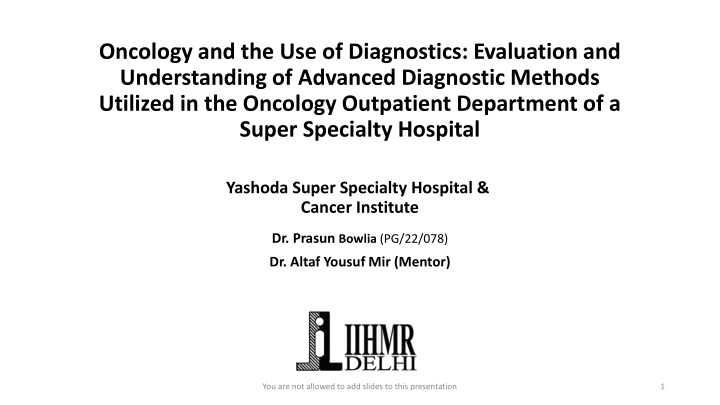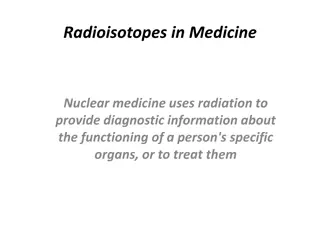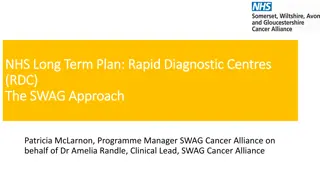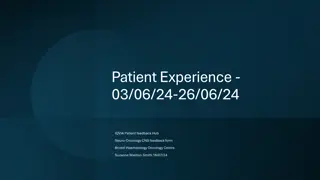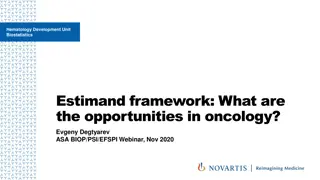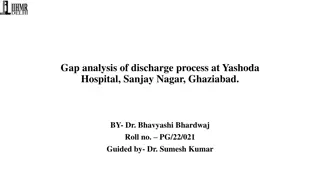Evaluation of Advanced Diagnostic Methods in Oncology OPD at Yashoda Super Specialty Hospital
Cancer diagnosis and treatment necessitate continuous advancements. This research delves into the utilization of diagnostic tests in the oncology outpatient department of a super specialty hospital. Explore the objectives, methodology, and research questions to understand the diagnostic landscape in the context of cancer care.
Download Presentation

Please find below an Image/Link to download the presentation.
The content on the website is provided AS IS for your information and personal use only. It may not be sold, licensed, or shared on other websites without obtaining consent from the author.If you encounter any issues during the download, it is possible that the publisher has removed the file from their server.
You are allowed to download the files provided on this website for personal or commercial use, subject to the condition that they are used lawfully. All files are the property of their respective owners.
The content on the website is provided AS IS for your information and personal use only. It may not be sold, licensed, or shared on other websites without obtaining consent from the author.
E N D
Presentation Transcript
Oncology and the Use of Diagnostics: Evaluation and Understanding of Advanced Diagnostic Methods Utilized in the Oncology Outpatient Department of a Super Specialty Hospital Yashoda Super Specialty Hospital & Cancer Institute Dr. Prasun Bowlia (PG/22/078) Dr. Altaf Yousuf Mir (Mentor) You are not allowed to add slides to this presentation 1
Mentor Approval Mentor Approval You are not allowed to add slides to this presentation 2
Introduction (1/2) Introduction (1/2) Cancer remains a leading global cause of morbidity and mortality, necessitating ongoing advancements in diagnosis, treatment, and management. Its complex genetic, molecular, and phenotypic profiles challenge effective treatment. In an oncology outpatient department (OPD) at a super specialty hospital, timely and accurate diagnosis is vital for effective treatment planning and patient management. This research aims to analyse the range of diagnostic investigations prescribed daily in oncology opd and also to understand how tests are being utilized. You are not allowed to add slides to this presentation 3
Objectives of Your Study Objectives of Your Study RESEARCH OBJECTIVE: To evaluate and understand the various advanced diagnostic methods utilized in the oncology outpatient department (OPD) of a super specialty hospital. RESEARCH QUESTION: 1. What is the percentage of diagnostic tests advised during initial consultations compared to follow-up consultations? 2. What are the most frequently advised diagnostic tests in the oncology outpatient department (OPD)? 3. What are different diagnostic tests advised in relation to the type of cancer? You are not allowed to add slides to this presentation 4
Methodology (1/2) Methodology (1/2) Study Design: This study will employ a prospective, cross-sectional descriptive design, collecting data over a period of two consecutive months. Study Area: The research will be conducted in the oncology outpatient department (OPD) of a super specialty hospital, which provides a conducive environment for studying how diagnostic tools are utilized in medical oncology. Study Population: The study population will consist of medical oncology patients who visit the oncology OPD during the study period. SAMPLING: The sampling method for this study will utilize a purposive sampling approach, encompassing all medical oncology patients those who have been prescribed diagnostic investigations, will be employed. This method ensures that every eligible patient presenting at the OPD for treatment during the study period is included in the sample. Sample Size: A total of 280 patients will be included in the study. You are not allowed to add slides to this presentation 5
Methodology (2/2) Methodology (2/2) Study Variable Patient Demographics: Unique Health Identification (UHID) Clinical Information: Diagnosis, Tests prescribed, First consultation or Follow-up consultation . Data Analysis- Data will be analysed using Microsoft Excel. The analysis will include: Descriptive statistics to summarize patient demographics and clinical characteristics Analysis of diagnostic tests prescribed. Charts, diagrams, and tables to visually represent data and facilitate understanding of key findings. You are not allowed to add slides to this presentation 6
Results (1/3) Results (1/3) You are not allowed to add slides to this presentation 7
Results (2/3) Results (2/3) 8
Test advised Based on the Type of CA Test advised Based on the Type of CA - - Results (3/3) Results (3/3) You are not allowed to add slides to this presentation 9
Discussion (1/2) Discussion (1/2) The bar chart 1 represents a comparison between the number of initial consultations and follow-up consultations for various medical tests and procedures. X-Axis: Lists the medical tests and procedures, ranging from imaging techniques (like MRI, PET-CT, and CT scans), biopsies, blood tests, and specific markers. Y-Axis: Indicates the percentage of the test being advised. Imaging Techniques: Pet-CT is observed to be advised in both initial and follow-up consultation. Biopsies: Bx. USG Guided shows a peak in initial consultations compared to follow-up consultations. Bx. BRONCHOSCOPY and Bx. CORE NEEDLE have notable entries, with Bx. BRONCHOSCOPY having slightly more initial consultations. Blood Tests and Markers: CBC, LFT, PT/INR and KFT are frequently conducted, with CBC having a higher number of initial consultations. The bar chart titled "Most Frequently Advised Test" illustrates the percentage distribution of various medical tests and procedures that are commonly recommended. X-Axis: Lists the medical tests and procedures. Y-Axis: Represents the percentage (%) of each test or procedure Key Observations: You are not allowed to add slides to this presentation 10
Discussion (2/2) Discussion (2/2) Top Advised Tests: KFT (Kidney Function Test) is the most frequently advised test, with a percentage close to 10%. PET-CT and CBC (Complete Blood Count) are also highly advised, both hovering around the 9% mark. LFT (Liver Function Test) and PT/INR follow, with percentages close to 8% and 7% respectively. Significant Tests: HIV, HBsAg, Anti-HCV and ECHO have notable percentages around 6%. ER, PR, HER2NEU and CEA are frequently advised with percentages around 5.5%. AFP, CHEST X-RAY, and Bx. CT Guided show percentages around 4% The bar chart titled "BLADDER CA" illustrates the percentage distribution of various investigations recommended for bladder cancer patients. Similarly, charts for breast, prostate, and ovary cancers highlight specific tests advised for each type. For bladder cancer, CYSTOSCOPY and USG KUB are more frequently recommended. For prostate cancer, the PSA test is prominent, and for hepatocellular carcinoma, AFP is commonly advised. These charts reveal the preferred tests for different cancer types. You are not allowed to add slides to this presentation 11
Conclusion Conclusion The charts underscore the necessity of tailored diagnostic strategies, with specific tests prioritized based on cancer type and stage of consultation. Understanding these patterns can help in optimizing diagnostic workflows, improving early detection, and enhancing patient management. You are not allowed to add slides to this presentation 12
References (Only Vancouver Style) References (Only Vancouver Style) National Cancer Institute. Diagnosis of cancer [Internet]. 2023 [cited 2024 Jul 20]. Available from: https://www.cancer.gov/about-cancer/diagnosis-staging/diagnosis National Center for Biotechnology Information. Introduction to cancer biology [Internet]. 2023 [cited 2024 Jul 20]. Available from: https://www.ncbi.nlm.nih.gov/books/NBK1247/ National Cancer Institute. Types of cancer treatment [Internet]. 2023 [cited 2024 Jul 20]. Available from: https://www.cancer.gov/about-cancer/treatment/types American Association for Cancer Research. Biomarkers for screening, diagnosis, and monitoring [Internet]. 2023 [cited 2024 Jul 20]. Available from: https://aacrjournals.org/cebp/article/21/11/1902/157928/Biomarkers-for-Screening- Diagnosis-and-Monitoring You are not allowed to add slides to this presentation 13
Thank You Any Questions You are not allowed to add slides to this presentation 14
Pictorial Journey (1/2) Pictorial Journey (1/2) You are not allowed to add slides to this presentation 15
